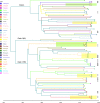The Genomic Context for the Evolution and Transmission of Community-Associated Staphylococcus aureus ST59 Through the Food Chain
- PMID: 32256477
- PMCID: PMC7090029
- DOI: 10.3389/fmicb.2020.00422
The Genomic Context for the Evolution and Transmission of Community-Associated Staphylococcus aureus ST59 Through the Food Chain
Abstract
Sequence type 59 (ST59) is a predominant clonal lineage of community-acquired, methicillin-resistant Staphylococcus aureus (CA-MRSA) in Asia. Despite its increasing clinical relevance in China, the evolution and geographic expansion of ST59 has been relatively uncared for. Previous study has shown that ST59 was the predominant clone in food-related MRSA in China. This study compared the genomes of 87 clonal complex (CC) 59 S. aureus isolates sourced from food chain and infection cases to reconstruct the molecular evolution and geographical spread of ST59. Accordingly, three major sub-clades of ST59 were identified and these did not correlate with isolation source or location. Phylogenetic analysis estimated that ST59 in mainland China diverged from a most common recent ancestor around 1974, and most of the cases of cross-country transmission occurred between 1987 and 2000. Notably, two recent events of cross-country transmission through the food chain were observed, the isolates from these events diverged within relatively short time intervals. These isolates also showed high similarity in terms of their core genome, accessory genes, and antibiotic resistance patterns. These findings provide a valuable insight into the potential route of ST59 expansion in China and indicate a need for robust food chain surveillance to prevent the spread of this pathogen.
Keywords: ST59 lineage; Staphylococcus aureus; food chain; molecular evolution; transmission.
Copyright © 2020 Pang, Wu, Zhang, Huang, Wu, Zhang, Li, Ding, Zhang, Chen, Wei, Zhang, Gu, Zhou, Liang, Li and Wu.
Figures






Similar articles
-
A comparative genomic analysis between methicillin-resistant Staphylococcus aureus strains of hospital acquired and community infections in Yunnan province of China.BMC Infect Dis. 2020 Feb 13;20(1):137. doi: 10.1186/s12879-020-4866-6. BMC Infect Dis. 2020. PMID: 32054452 Free PMC article.
-
Genomic Epidemiology and Characterization of Methicillin-Resistant Staphylococcus aureus from Bloodstream Infections in China.mSystems. 2021 Dec 21;6(6):e0083721. doi: 10.1128/mSystems.00837-21. Epub 2021 Nov 2. mSystems. 2021. PMID: 34726482 Free PMC article.
-
Genome-based surveillance reveals cross-transmission of MRSA ST59 between humans and retail livestock products in Hanzhong, China.Front Microbiol. 2024 Apr 29;15:1392134. doi: 10.3389/fmicb.2024.1392134. eCollection 2024. Front Microbiol. 2024. PMID: 38741738 Free PMC article.
-
Community-associated meticillin-resistant Staphylococcus aureus in children in Taiwan, 2000s.Int J Antimicrob Agents. 2011 Jul;38(1):2-8. doi: 10.1016/j.ijantimicag.2011.01.011. Epub 2011 Mar 11. Int J Antimicrob Agents. 2011. PMID: 21397461 Review.
-
Changing epidemiology of community-associated methicillin-resistant Staphylococcus aureus in the Asia-Pacific region.Expert Rev Anti Infect Ther. 2016 Nov;14(11):1007-1022. doi: 10.1080/14787210.2016.1236684. Epub 2016 Sep 23. Expert Rev Anti Infect Ther. 2016. PMID: 27645549 Review.
Cited by
-
Staphylococcus aureus ST59: Concurrent but Separate Evolution of North American and East Asian Lineages.Front Microbiol. 2021 Feb 10;12:631845. doi: 10.3389/fmicb.2021.631845. eCollection 2021. Front Microbiol. 2021. PMID: 33643261 Free PMC article.
-
The Prevalence, Epidemiological, and Molecular Characterization of Methicillin-Resistant Staphylococcus aureus (MRSA) in Macau (2017-2022).Microorganisms. 2024 Jan 12;12(1):148. doi: 10.3390/microorganisms12010148. Microorganisms. 2024. PMID: 38257975 Free PMC article.
-
Whole-Genome Sequencing and Comparative Genomics Analysis of a Newly Emerged Multidrug-Resistant Klebsiella pneumoniae Isolate of ST967.Microbiol Spectr. 2023 Jun 15;11(3):e0401122. doi: 10.1128/spectrum.04011-22. Epub 2023 Apr 6. Microbiol Spectr. 2023. PMID: 37022188 Free PMC article.
-
Evolution of community-associated MRSA: a 20-year genomic and epidemiological study in Region Örebro County, Sweden.Front Microbiol. 2024 Dec 23;15:1504860. doi: 10.3389/fmicb.2024.1504860. eCollection 2024. Front Microbiol. 2024. PMID: 39764449 Free PMC article.
-
Distribution of Antimicrobial Resistance and Biofilm Production Genes in the Genomic Sequences of S. aureus: A Global In Silico Analysis.Antibiotics (Basel). 2025 Apr 1;14(4):364. doi: 10.3390/antibiotics14040364. Antibiotics (Basel). 2025. PMID: 40298499 Free PMC article.
References
-
- Abulreesh H. H. (2011). “Multidrug-resistant staphylococci in the environment,” in Proceedings of the 2011 International Conference on Biotechnology and Environment Management. Singapore.
LinkOut - more resources
Full Text Sources

